
What is carbon capture?
Carbon dioxide (CO2) emissions generated by human activities have led to an accumulation of greenhouse gases in the atmosphere that is causing an increase in
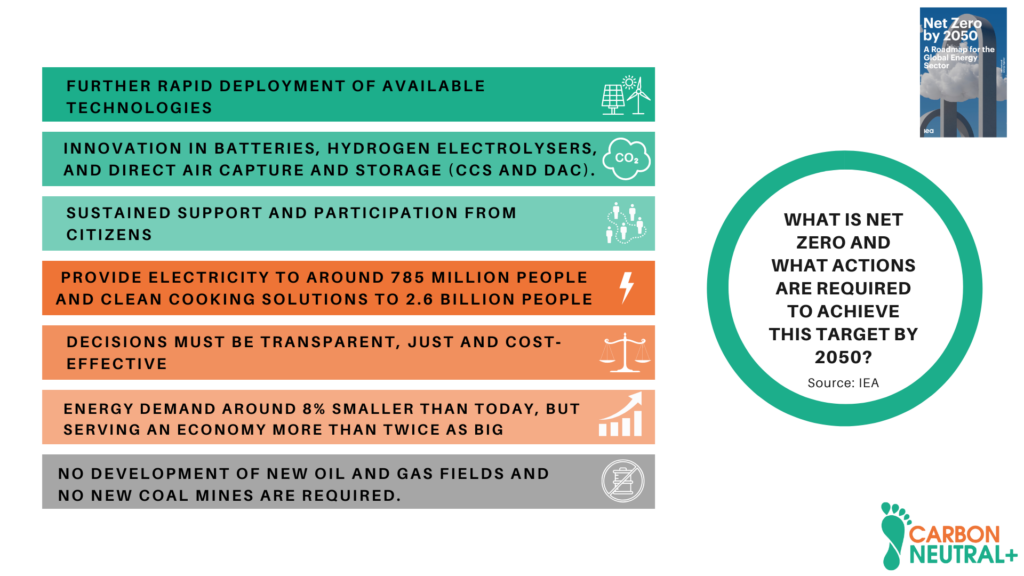
Climate change is one of the greatest concerns of our time. This phenomenon is generating consequences that are difficult to reverse, such as an increase in global and ocean temperatures, rising sea levels and droughts that directly affect the food security of many communities and territories.
Human-generated greenhouse gas emissions are the main cause of climate change. That is why, in order to curb global warming, it is necessary to reduce these emissions.
On this path, we seek to meet the objectives established in the Paris Agreement, not only to limit the Earth’s temperature increase to 1.5 degrees, but also to achieve a net balance of carbon emissions, also known as Net Zero.
But what is Net Zero?
In this article we will tell you what Net Zero is, how companies are involved in this commitment, and what are the guidelines established by organizations such as the IEA or SBTi to meet this important goal for our planet.
According to the Net Zero Climate initiative, Net Zero refers to a state in which the greenhouse gases that are released are balanced through an activity that allows them to be removed from the atmosphere.
The Paris Agreement highlights the need to reach a Net Zero state. This requires a balance between anthropogenic greenhouse gas (GHG) emissions and their removals through sinks by the second half of the 21st century.
The “Net Zero” objective implies, in the first instance, reducing our GHG emissions as much as possible. Subsequently, we must ensure that all remaining emissions are offset through their removal.
The word “Net” is important because it is extremely difficult for us to reduce 100% of our GHG emissions by 2050. That is why we need carbon capture solutions to scale up in the coming years, such as those offered by carbon credits.
It is important to mention that the removals mentioned should be permanent. This implies actions to protect the carbon sinks that capture these emissions over time, so that the captured emissions are not released back into the atmosphere.
If you want to know the difference between Net Zero and carbon neutrality you can access our article: What is it and how to achieve carbon neutrality?
Achieving Net Zero will not be easy. It will require significant changes in the way we produce and consume energy, as well as in the way we live and work.
Countries and companies face major challenges in terms of investment in clean technologies, the creation of effective policies and regulations, and the need for greater international cooperation.
One of the biggest challenges is associated with the transformation of the energy industry, as this industry cuts across all the activities we humans carry out in our daily lives.
The following are the main points that the International Energy Agency establishes in its report “Net Zero by 2050” for the transformation of this industry in the coming years.
According to the IEA report “Net Zero by 2050”, there are some key points that all public and private organizations must consider in the energy transition in the coming years if they wish to achieve Net Zero by 2050.
The energy sector is responsible for approximately 75% of the greenhouse gas emissions that cause climate change. That is why this sector has a huge responsibility in the GHG reduction that the world needs to meet the Paris Agreement targets. According to the IEA, this will require a complete transformation of the way we produce, transport and consume energy today.
Below, we list some of the key points from this report:
The Net Zero 2050 goal requires rapid deployment of currently available clean energy technologies. This implies that throughout this decade major innovation efforts will be made to bring new clean energy production technologies to market on time.
Finally, it is also mentioned that most of the global GHG emission reductions by 2030 will come from technologies that are available today.
These three technology areas are vital contributors to reducing GHG emissions between 2030 and 2050 on the path to Net Zero.
The changes that are required by this transition will affect multiple aspects of people’s lives, from transportation, heating and cooking to urban planning and employment.
According to data in this report, it is estimated that around 55% of the cumulative emissions reductions on the Net Zero pathway are linked to consumer decisions.
Actions that can have a major impact include purchasing lower-emission vehicles, retrofitting homes with energy-efficient technologies, and behavioral changes such as replacing car trips with walking or cycling.
Emissions reductions have to go together with efforts to ensure energy access for every citizen on the planet by 2030.
This will cost around $40 billion per year, which is equivalent to approximately 1% of the average annual investment in the energy sector, while bringing significant co-benefits from reduced indoor air pollution.
A special call for attention here goes to local governments, who must ensure that clean energy transitions are people-centered and inclusive.
This will undoubtedly require more efficient use of energy and resources.
At the same time, it requires changes in consumer behavior that can offset the increased demand for energy services as the world economy grows and access to energy expands to all the inhabitants of our planet.
The Net Zero path requires a sharp decline in demand for fossil fuels. Coal demand must be reduced by 98% to less than 1% of total energy consumption by 2050. Natural gas demand must decrease by 55% and oil demand by 75% in order to meet the Net Zero target by 2050.
Below is a summary of the above points from the IEA report:
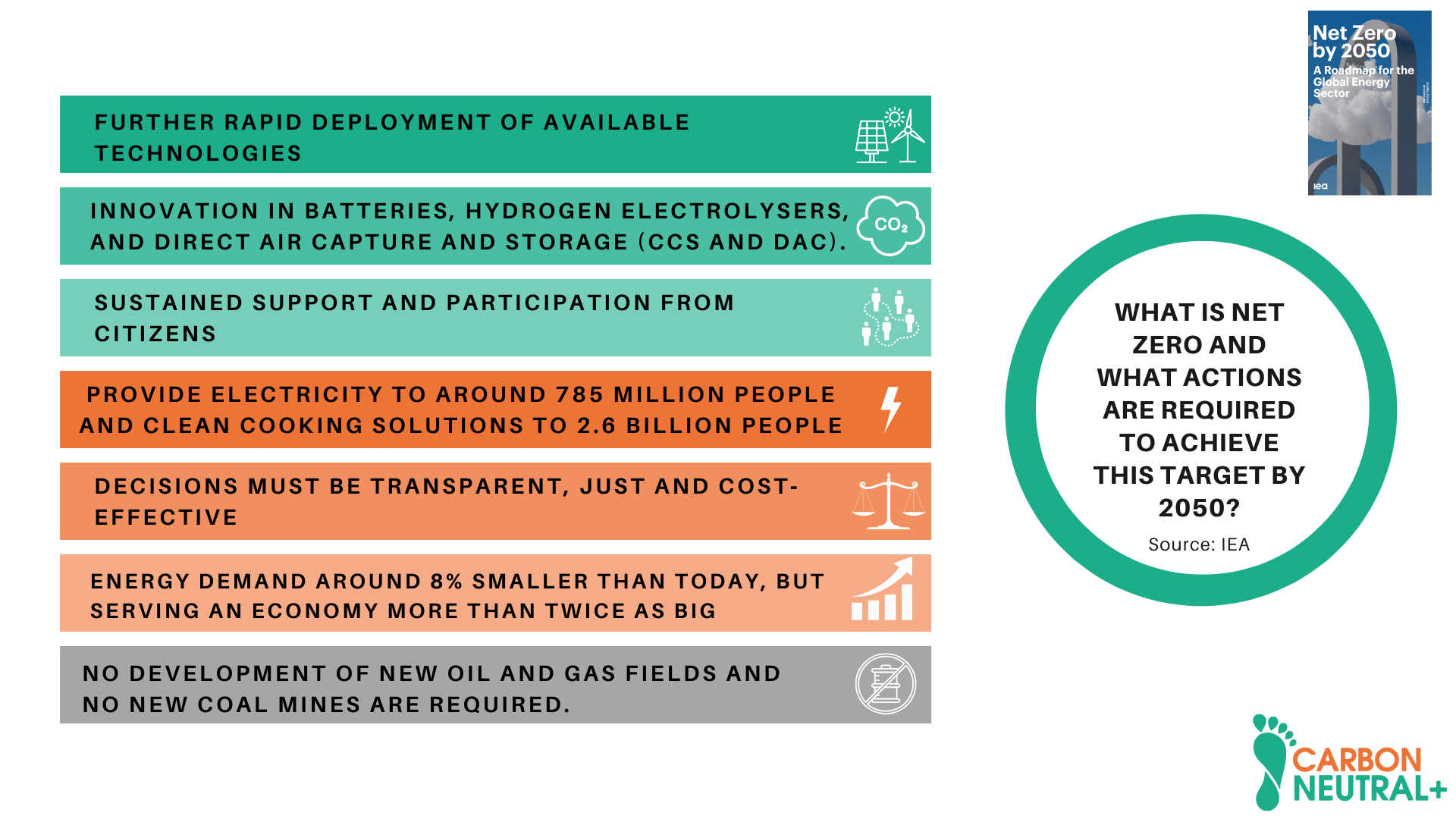
According to a recent UN report there is now a growing set of countries, cities, companies and other institutions that are committed to achieving Net Zero targets.
There are more than 70 countries, including those that generate the largest amount of current GHG emissions (China, the United States and the EU) that have set zero emissions targets. These countries account for 76% of global GHG emissions.
On the other hand, from the private sector, there are already more than 3000 companies and financial institutions working together with the Science Based Targets (SBT) initiative to reduce their emissions in line with current climate science.
Finally, more than 1,000 cities around the world are also already part of the Net Zero fight, and have committed to take action to meet these targets and halve their GHG emissions by 2050.
The Net Zero standard was developed by the SBTi to guide companies on the path to Net Zero transition. This standard seeks to make this transformation of our industrial and economic systems consistent with global sustainability goals and the biophysical limits of our planet.
According to this standard, to achieve Net Zero status at the corporate level, companies must drastically reduce their emissions and offset the remainder that they cannot mitigate.
The SBTi standard defines corporate Net Zero as:
In turn, the standard establishes four key elements that make up a corporate net-zero goal:
Climate change is a real threat to our planet and our species. Climate change impacts include sea level rise, intensification of extreme weather events and loss of biodiversity.
The 2015 Paris Agreement has been an important milestone on the road to Net Zero. This is because it is there that most countries committed to achieving net carbon emissions balance by mid-century (2050).
To avoid the worst impacts of climate change, it is necessary to reduce greenhouse gas emissions and achieve net carbon balance. It is important to know in depth what Net Zero is and to implement the necessary actions to achieve it.
At Carbon Neutral+, we have a fundamental platform to accompany companies on the road to Net Zero. We offer solutions to measure, reduce and offset greenhouse gas emissions, allowing companies to meet climate goals. If your company wants to achieve a sustainable business model committed to the environment, contact us and we will accompany you on this path.

Carbon dioxide (CO2) emissions generated by human activities have led to an accumulation of greenhouse gases in the atmosphere that is causing an increase in
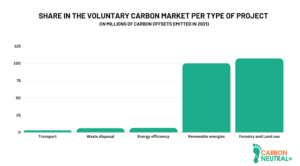
According to the Emissions Gap Report 2022, the growth rate of global greenhouse gas (GHG) emissions has declined over the last decade. Between 2010 and
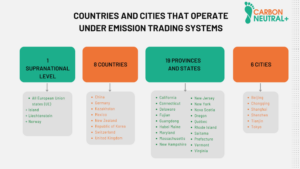
As international agreements related to corporate greenhouse gas emissions (GHG) come into force, the regulations associated with the generation of these emissions increase. This is
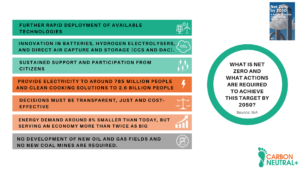
Climate change is one of the greatest concerns of our time. This phenomenon is generating consequences that are difficult to reverse, such as an increase

The Paris Agreement is an international agreement adopted on December 12, 2015 during the United Nations Climate Change Conference (COP21) in Paris, France. One of
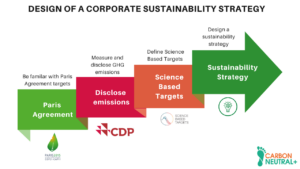
As the world faces the looming effects of climate change, more and more companies are recognizing the importance of adopting sustainable strategies that aim to
| Cookie | Duration | Description |
|---|---|---|
| cookielawinfo-checkbox-analytics | 11 months | This cookie is set by GDPR Cookie Consent plugin. The cookie is used to store the user consent for the cookies in the category "Analytics". |
| cookielawinfo-checkbox-functional | 11 months | The cookie is set by GDPR cookie consent to record the user consent for the cookies in the category "Functional". |
| cookielawinfo-checkbox-necessary | 11 months | This cookie is set by GDPR Cookie Consent plugin. The cookies is used to store the user consent for the cookies in the category "Necessary". |
| cookielawinfo-checkbox-others | 11 months | This cookie is set by GDPR Cookie Consent plugin. The cookie is used to store the user consent for the cookies in the category "Other. |
| cookielawinfo-checkbox-performance | 11 months | This cookie is set by GDPR Cookie Consent plugin. The cookie is used to store the user consent for the cookies in the category "Performance". |
| viewed_cookie_policy | 11 months | The cookie is set by the GDPR Cookie Consent plugin and is used to store whether or not user has consented to the use of cookies. It does not store any personal data. |